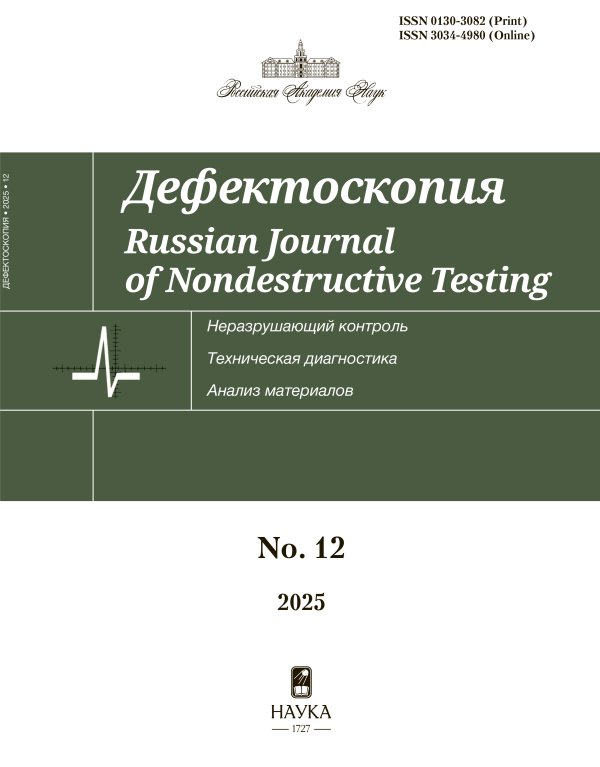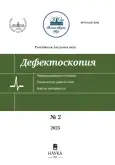№ 2 (2025)
Акустические методы
Исследование метода мониторинга и распознавания утечек в водородных клапанах высокого давления
Аннотация
Водородные клапаны высокого давления подвергаются мгновенному воздействию потока водорода и многократному действию старт-стоп во время эксплуатации, и существует потенциальный риск утечки. В данной работе исследуются вопросы мониторинга и идентификации утечек в водородных клапанах для обеспечения их эксплуатационной надежности. Во-первых, система мониторинга акустических сигналов была построена на основе платформы для испытания газовой герметичности водородных клапанов высокого давления, и проведен анализ характеристик клапанов во временной области при различных условиях утечки. Во-вторых, характеристики частотной области извлекаются с помощью комбинации вариационного модального разложения и вейвлетного разложения пакетов. В конечном итоге для распознавания паттернов акустических сигналов используются сеть обратного распространения (BP) и сверточная нейронная сеть (CNN), причем параметры временной и частотной областей подаются на вход независимо. Результаты показывают, что точность сетей BP и CNN, основанных на признаках частотной области, значительно повысилась до 93,33 и 91,67 % соответственно. В данной работе получен метод выделения признаков и распознавания образов для водородных клапанов, который служит основой для точного и эффективного распознавания состояния утечки водородных клапанов высокого давления в процессе эксплуатации.
 3-16
3-16


Улучшение видимости глубоких дефектов при ультразвуковом контроле толстостенных полиэтиленовых труб с помощью частотно-временной концентрации энергии
Аннотация
Ультразвуковой контроль толстостенных полиэтиленовых труб сопряжен с проблемой потери энергии, что приводит к появлению слабых эхосигналов от глубоких дефектов. Чтобы улучшить обнаружение этих слабых сигналов, представлен метод концентрации энергии во времени и частоте. Дробное адаптивное суперлетное преобразование объединяет результаты нескольких вейвлет-преобразований с различными полосами пропускания путем геометрического усреднения, обеспечивая более широкие возможности анализа временных частот по сравнению с одиночными вейвлет-преобразованиями. Однако его представление временных частот имеет проблему мгновенного отклонения частоты. Предлагаемый метод решает эту проблему путем вложения мгновенной частоты, что приводит к повышению точности оценки мгновенной частоты. Численный анализ сигналов показывает более высокую точность оценки мгновенной частоты с помощью этого метода по сравнению с другими методами обработки временных частот. Применительно к обнаружению глубоких дефектов в толстостенных полиэтиленовых трубах метод показывает увеличение способности усиления слабого сигнала на 18,9 % по сравнению с непрерывным вейвлет-преобразованием. Наконец, результаты демонстрируют точность метода в определении мгновенных изменений частоты и усилении мгновенных амплитуд слабых сигналов, предлагая перспективный подход для обнаружения глубоких дефектов в толстостенных полиэтиленовых трубах.
 17-27
17-27


Электромагнитные методы
Гистерезисная интерференция полей дефектов
Аннотация
Представлены расчетные начальные и гистерезисные ветви электрического напряжения U (H) в импульсном магнитном поле напряженностью H, соответствующие ветвям намагниченности в действующем магнитном поле и остаточной намагниченности объекта из ферромагнитного материала, и аналогичные ветви используемого магнитного носителя (МН). Воздействие на объект с МН осуществляли импульсами магнитного поля с получением стационарных состояний намагниченности объекта с внутренним дефектом, поле которого моделировано полем линейного индуктора, построением пространственных распределений гистерезисных интерференций (HI) и созданием программ расчета HI, позволяющих повысить точность контроля свойств объектов.
 28-38
28-38


Обратная задача магнитостатики для однородно намагниченных тел в рамках двумерной модели
Аннотация
Для однородно намагниченных тел в рамках обратной задачи магнитостатики в двумерном случае получено нелинейное одномерное интегродифференциальное уравнение на функцию одного переменного, которая определяет форму магнетика или полости в нем по измеренной напряженности результирующего поля вне тела. Предложен алгоритм численного решения этого уравнения, сводящийся к минимизации функции нескольких переменных. Составлена программа на языке ФОРТРАН, реализующая указанный алгоритм. В качестве тестового и иллюстративного примера по известной напряженности результирующего поля вне магнетика найдено сечение однородного бесконечного цилиндра, находящегося в немагнитной и непрозрачной среде.
 39-52
39-52


Комплексное применение методов неразрушающего контроля
Измерение степени анизотропии электрофизических свойств композита эпоксидная смола — магнитная жидкость — углеродные нанотрубки
Аннотация
Исследованы электрофизические свойства материала, представляющего собой композит из эпоксидной смолы, магнитной жидкости и углеродных нанотрубок. Показано, что в композитах, высушенных в присутствии магнитного поля, образуются вытянутые проводящие структуры, состоящие из углеродных нанотрубок и магнитной жидкости. Их наличием обусловлено появление анизотропии электрофизических свойств такого рода композитов. Анизотропия свойств исследовалась СВЧ-волноводными методами, по частотной зависимости коэффициента отражения СВЧ-излучения от периодической структуры, в которой в качестве нарушенного слоя использовался исследуемый композит. Было выявлено, что электрофизические свойства композита зависят от величины и направления индукции магнитного поля, а также от изменения концентрации составных частей в композите. Произведено численное моделирование и показана важность учета анизотропии электрофизических свойств образованных структур при расчете интегральных параметров композита.
 53-66
53-66


Дефектоскопические истории
Препятствуют ли неоднородности валиков ультразвуковому контролю сварных швов ограниченной толщины?
Аннотация
Традиционный ультразвуковой контроль качества сварных швов эхометодом часто сталкивается с проблемой выявления сигналов от дефектов на фоне помех от неровностей сварного шва. В статье приведен пример того, как конструктивные особенности сварных швов, которые обычно мешают проведению дефектоскопии, можно использовать для подавления таких помех и разработки высокопроизводительной и достоверной технологии ультразвукового контроля. В данном случае речь идет о сварных стыках труб малого диаметра. Описано решение этой задачи с применением хордовой схемы прозвучивания, дана краткая историческая справка об этом решении и примеры реализации, в том числе — при контроле сварных стыков с неоднородными характеристиками.
 67-72
67-72












